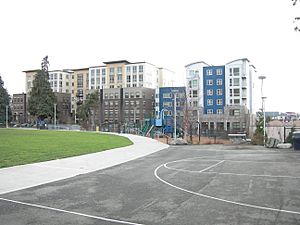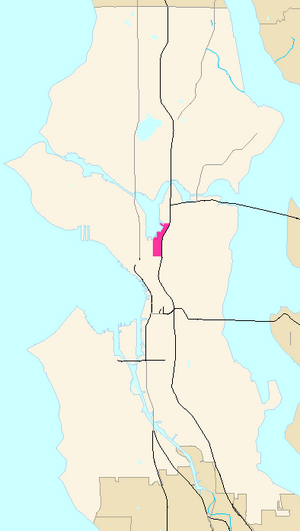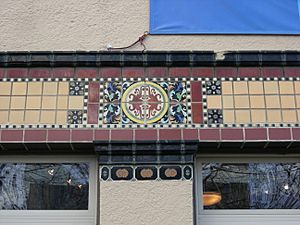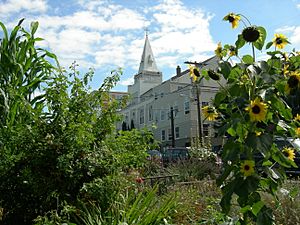Cascade, Seattle facts for kids
Quick facts for kids
Cascade, Seattle
|
|
|---|---|
|
Seattle Neighborhood
|
|

The Cascade Playground (former playground of the long-demolished Cascade School)
|
|

Cascade Highlighted in Pink
|
|
| Country | United States |
| State | Washington |
| County | King |
| City | Seattle |
| Zip Code |
98109
|
| Area Code | 206 |
Cascade is a neighborhood in Seattle, Washington, United States. It's right next to Downtown Seattle and South Lake Union. It's bordered by Fairview Avenue North to the west and Interstate 5 to the east. To the north is Eastlake, and to the south is Denny Triangle.
Cascade is one of Seattle's oldest neighborhoods. It used to be much larger, stretching further west, south, and east. Today, you can find historic buildings like St. Spiridon's Orthodox Cathedral and Immanuel Lutheran Church here. In 2007, a cool development called Alley24 was built. It kept the front of the old New Richmond Laundry Building, which is a City of Seattle Landmark. This new building is home to the architecture firm NBBJ.
| Top - 0-9 A B C D E F G H I J K L M N O P Q R S T U V W X Y Z |
Discovering Cascade: A Seattle Neighborhood
Cascade started as a working-class neighborhood in the late 1800s and early 1900s. It had homes and was one of Seattle's first industrial areas. It was once home to St. Demetrios Greek Orthodox Church. It still has St. Spiridon Russian Orthodox Cathedral, which opened in 1895, and Immanuel Lutheran Church, which opened in 1890.
Early Days and Pioneers
When Seattle was first settled, the Cascade area was covered in thick forests. In the 1860s, pioneers like David Denny and Thomas Mercer claimed land here. The first developments were a bit west, near southwest Lake Union. This area became a hub for transportation, and Denny built the first sawmill there. By the 1880s, more mills and cleared land led to Cascade becoming a mix of homes and factories. It was connected to water transportation on the lake.
Another important pioneer was Margaret Pontius. She was known for her amazing work as a foster parent, helping many children. She and her husband, Rezius Pontius, lived in the neighborhood by 1885. By 1889, they built a beautiful Queen Anne style mansion.
Many people from different countries settled in Cascade. These included Russians, Swedes, Norwegians, and Greeks. In 1894, the Cascade School opened, and that's when the neighborhood got its name. As more people moved in, the school grew in 1904 and 1908. Businesses in Cascade at this time included sawmills, boat yards, furniture shops, grocery stores, and laundries.
City planners like John Charles Olmsted (in 1903) and Virgil Bogue (in 1910–1911) thought Cascade was best for factories. Olmsted wanted a small park by the lake, but it didn't happen. The Denny Regrade No. 1 project, finished in 1911, removed a big hill. This made it much easier to get to Cascade from downtown Seattle. The Ford Motor Company built its first factory west of the Mississippi River here in 1914. When the Lake Washington Ship Canal opened in 1917, more shipping and factory work came to the area. Cascade also became a center for large laundries and machine shops. The laundries in Cascade played a big part in Seattle's labor history. Workers successfully fought for an 8-hour day between 1917 and 1918.
The Great Depression Years
During the Great Depression, which was a time of economic hardship, Cascade faced tough times. The neighborhood's economy and population began to shrink. The most stable jobs left were in shipbuilding and other water-related activities. Howard Wright General Contractors, a construction company, started operating here and is still located in the area today.
There was also a small shopping area on Eastlake Avenue. It had grocery stores, a pharmacy, a meat shop, and places for car and furniture repair. There were also beauty parlors, barbershops, and places to eat. Many of these buildings on the west side of the street are still standing. However, Interstate 5 was built later, cutting off this area from Capitol Hill. This made it less of a busy shopping district.
Changes After World War II
The decline of the Great Depression was briefly stopped by World War II. The U.S. Navy built a reserve center, and Kenworth expanded a factory. But after the war, the decline continued. In 1949, an earthquake damaged the Cascade School. There was a big debate about whether to fix it. Local businesses, especially the Seattle Times, wanted the neighborhood to be more industrial and less residential. So, the school was torn down. A warehouse for the school district was built in its place, but the school's playground remained as a public park.
Also in 1949, the Washington Teachers Credit Union started in Cascade. It later became part of PEMCO Financial Services, which is still based in the neighborhood. New rules in 1956 stopped new homes from being built in Cascade. The city also planned two new freeways through the area. One, the Bay Freeway, was never built. But Interstate 5 was built in 1962. This freeway destroyed many homes and businesses and completely cut off Cascade from Capitol Hill. Before, many streets and stairways connected them. Now, only Denny Way connects the two neighborhoods directly.
The 1960s and 1970s
In the 1960s, the Seattle Times newspaper bought and tore down many homes near its headquarters. They wanted space for parking and future buildings. This caused some problems between the newspaper and the neighborhood.
Around the same time, the University of Washington's College of Architecture and Urban Planning called the area "struggling." A plan for an elevated freeway that would have cut off Cascade from Lake Union was voted down in 1972. Cascade continued as a neighborhood with working-class homes and light industries.
In the early 1970s, activists started the Cascade Shelter Project. They built dome-shaped homes on empty lots to live in. Reports in 1975 and 1977 suggested that Cascade should be protected as a historic residential area. However, the city council didn't take action on these ideas.
The 1980s and 1990s: A New Era
As Seattle's economy grew in the late 1980s, Cascade's affordable land and central location started attracting new businesses. The Fred Hutchinson Cancer Research Center built its campus here. The old City Light Steam Plant, which used to make electricity, became the headquarters for Zymogenetics. This marked the beginning of big changes in the neighborhood.
A plan to turn a large area west of Cascade into a park was voted down twice. However, the neighborhood continued to change, largely due to developer Paul Allen's company, Vulcan Northwest.
In the 1990s, two big changes happened in the southern part of Cascade. The old St. Demetrios Church was torn down to build the new REI flagship store. Also, the Lillian Apartments, an old wooden building, were demolished by Vulcan Northwest. This demolition was opposed by groups who wanted to keep affordable housing.
Interesting People from Cascade
Teamsters labor leader Dave Beck grew up in Cascade. He went to the Cascade School and delivered newspapers there. He followed his mother into laundry work, which led him to become a labor organizer.
Another notable resident was cubist artist Nicolai Kuvshinoff and his wife Bertha Horne Kuvshinoff. Bertha had a unique painting style she called "phantasism." Both of their artworks are in the Seattle Art Museum. Nicolai came to Cascade from Russia in 1915. His father, Rev. Vasily Kuvshinoff, brought valuable religious items from the Romanovs, which he gave to St. Spiridon Orthodox Cathedral, where he was a priest. Nicolai Kuvshinoff may have painted religious murals in the Cathedral. The Kuvshinoffs lived and worked in Paris for a few years but returned to Cascade. They lived in the former Rodgers Tile Company building, which is now an outdoor equipment shop.
Cascade Playground: A Community Space

The Cascade Playground, also known as Cascade Park, was originally the playground for the old Cascade School. It has two play areas, a large field, a picnic table, and restrooms. Right next to the park is a community P-Patch, which is a garden where people can grow their own plants. In 2005, the playground got new improvements.
Sharing the block with the playground and P-Patch is the Cascade People's Center. This is a volunteer group that works with many local businesses, churches, and organizations. They help people in the community and work for fairness and justice.
By 1931, most of this block was owned by the City of Seattle or the School Board. However, some houses were still privately owned. By the end of 1931, these houses were sold and removed. There was a debate in the neighborhood about building the playground. In 1934, the group that wanted the playground won. Even in 1937, some people argued that the old Cascade School wasn't worth saving. They also felt that the neighborhood, which was becoming more industrial, didn't need a playfield.
Between 1934 and 1939, workers from the WPA built a retaining wall, the restrooms at the park's northeast corner, and a wading pool. The wading pool was originally part of a Japanese stone garden.
By the 1970s, the playground was described as "somewhat bleak" and known as the "Sahara Desert" by locals. In 1971, a renovation included a mural on the retaining wall. This mural was funded by the Seattle Arts Commission and designed by Mike Love and George Shayler. More improvements followed in 2005.
Important Landmarks and Historic Sites
Cascade is home to several buildings and structures that are recognized as important landmarks. These sites help tell the story of the neighborhood's past.
| Building or structure |
Address | Listing | Photo |
|---|---|---|---|
| Ford Assembly Plant Building Now Public Storage |
1155 Valley St. | Seattle landmark |  |
| Immanuel Lutheran Church | 1215 Thomas St. | Seattle landmark NRHP |
 |
| Jensen Block | 601-611 Eastlake Ave. E | Seattle landmark |  |
| Lake Union Steam Plant and Hydro House Now Zymogenetics |
1179 Eastlake Ave. E | Seattle landmark |  |
| New Richmond Laundry Now part of the Alley24 development |
224 Pontius Ave. N | Seattle landmark |  |
| St. Spiridon Russian Orthodox Cathedral | 400 Yale Ave. N | Seattle landmark |
 |
| Supply Laundry Building Now part of the Stackhouse development |
1265 Republican St. | Seattle landmark NRHP |
 |
There's also a part of the East Republican Street Stairway that is a Seattle landmark. It used to connect Cascade to Capitol Hill. However, the remaining part is now separated from Cascade by Interstate 5.
| Building or structure |
Address | Listing | Photo |
|---|---|---|---|
| East Republican Street Stairway | Between Melrose Ave. E and Bellevue Ave. E; Originally extended beyond Bellevue Ave. E to Eastlake Ave. E |
Seattle landmark |  |
Images for kids







